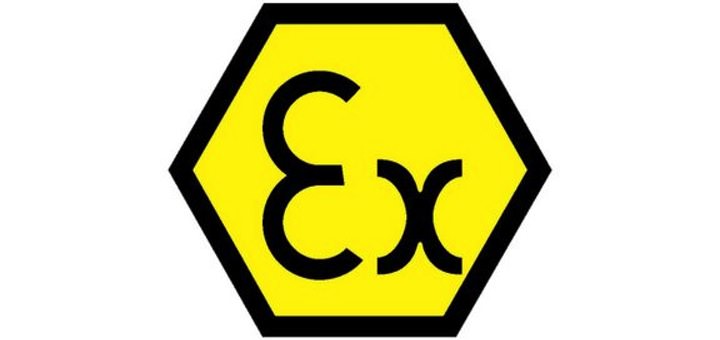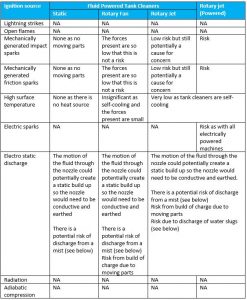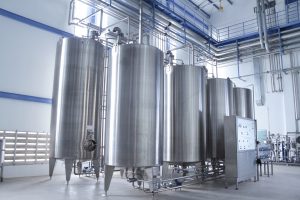
The process of cleaning tanks and vessels that contained flammable materials is a risky business. As tanks will be empty when the cleaning process is undertaken the potential for explosive vapours or dusts to be present is increased during the cleaning process. A petroleum tank that is empty is far more of an explosion risk than one that is full. This fact is well understood particularly in the marine industry.
Three large explosions during the cleaning of crude oil tankers in 1969 prompted significant research into the safety of tank cleaning operations. The conclusions were that the explosions were likely caused by the tank cleaning system itself rather than some other external ignition source. This prompted further research into making tank cleaning systems safe for use in explosive environments. The results of this investigation highlighted some perhaps unexpected sources of explosion risk and have underpinned much of the ATEX design compliance recommendations found today.
Potential sources of risk
The ATEX directive in general identifies nine potential sources of ignition. Not all are relevant to tank cleaning systems and some are relevant to only certain types of tank cleaner. Whilst there are many models of tank cleaning equipment on the market they can be all be broken down into four categories: static nozzles with no moving parts, spinning cleaners that rotate under fluid pressure, rotary jet cleaners that are fluid powered and jet cleaners that are motor driven. The table below summarises how the ignition sources apply to each class of tank cleaner.

Mechanically generated impact and friction sparks
Any moving parts could potentially act as these types of friction source if the forces in play are enough. For fluid powered rotary tank cleaners operating at low pressures (sub 4 bar) the forces in play are unlikely to pose any risk of friction and sparking. Nevertheless, the machine in question will need to be designed and inspected to ensure that all sensible precautions have been taken to mitigate this small risk. For higher pressure fluid driven tank washers and for motor powered tank washers the risk is significantly higher.
With tank cleaning heads that are entirely fluid powered the risk is far less simply because they automatically have some fail safes built in. The only potential source of impact or mechanical sparks would be a failure in the gearing system causing frictional heat build-up or an impact between two parts of the machine that would not normally make contact. In either case a fluid powered tank washer would almost certainly stop working and rotating very quickly thus automatically removing the explosion risk. This is not the case in motor powered tank cleaners so additional safety features such as a failsafe motor cut off system will need to be put in place by the manufacturer.
These would only apply to motor powered tank cleaners. Often this risk will be mitigated as the motor will sit outside the explosive environment. Any powered tank cleaner will always need to have sufficiently redundant safety features to ensure it remains fully earthed. For zone 0 environments this will mean having doubly redundant safety features such that even if one fails the machine can continue to operate safety.
High surface temperature
These risks are similar for mechanically generated sparks. Again, fluid powered tank washers will generally have a “natural” safety feature in that if over-heating were to occur then it would mean a serious failure in the gearing system which would tend to stop the machine from moving. More care needs to be taken with powered tank cleaners as a similar gear fault could potentially result in frictional heat build-up. As such, additional safety features will need to be built into the design of the tank cleaner.
Electrostatic discharge
This is perhaps the biggest explosion risk from tank cleaners. Any moving machine that is not earthed can build up a charge. Tank cleaning machines will generally be constructed of metal and will be spraying water both of which are excellent conductors of electricity. This means that under normal operation they should always remained fully earthed. That being said, there are still some areas of concern.

The water jets from rotary impingement cleaners could potentially hold a charge if they were not earthed. Under normal operation, cleaning jets would always be in contact with the tank or with the tank washer and thus remained earthed. If, however, the tank washer was to pulse jets for any reason producing slugs of water then research has shown that this is a potential source of electrostatic sparking.[1] In practice this risk can be eliminated by ensuring that the tank washers are installed in suitably sized tanks such that contact will always be made. This will be in the operating manual of the tank washer. Any ATEX certification is always contingent on operating the machine in line with the manual so it worth checking the recommended maximum tank size.
Another grey area is whether there is a spark risk from any water mist formed by the tank cleaner. All tank cleaners have the potential to create water mists even solid jet impingement cleaners which could potentially create some mist as the nozzle turns off and on. There has been some research conducted by the University of Southampton into risk associated with charged mists. The conclusions are mixed, but, the consensus is that although the risk from charged mists is probably very low it cannot be discounted.
The temperature of the mist influences its charge carrying potential. This, however, it is not a simple relationship. As the research is somewhat inconclusive the general recommendations are that wash fluid should be kept below 60Co for cleaning explosive environments. Other recommendations include not using chemical cleaners within these environments and not using recirculated water as both can potentially increase the charge carrying capacity of mists.
Conclusion
Tank cleaning heads are sometimes erroneously thought to be relatively safe from an explosion risk point of view. Most of the focus, when it comes to explosion risk, is on the more obvious risks from electrical and other powered machinery. Often a fluid powered rotary jet cleaner is ignored as a risk source. The reality is that tank cleaning operations are a most dangerous time. So, whilst it is true that the intrinsic risks of an ignition source are small when compared to other types of equipment, the very fact that a tank will contain a vapour residue when being cleaned means even those low risks are amplified and so cannot be ignored.
The research and development that has been conducted over the last few decades has led to the development of safe tank cleaning systems suitable for use in ATEX zone 0 environments. Several manufacturers have gone through the arduous and expensive process of ATEX certification for their tank cleaning ranges.
That’s the good news. The not so good news is that the copying and cloning of these machines leaves many rotary cleaners on the market that look very similar but which have no certification whatsoever. As such, using them relies entirely on the vague hope that the machine has actually been made properly and takes into account all the hard-won wisdom of the last few decades. If there is one takeaway piece of advice from this article, then it is to check that the tank cleaning head being used has a certification for the environment it is being used in. Do not ever be fobbed off with meaningless vagaries like “it conforms to ATEX specifications” or that it is somehow an “ATEX exempt design”. Unless it’s a completely non-moving tank cleaner (i.e. a static nozzle) then it must have ATEX certification.



